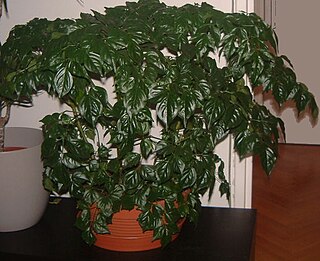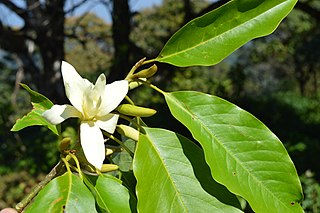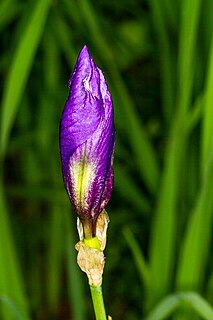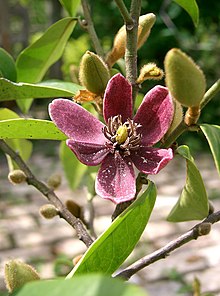
Magnolia is a large genus of about 210 to 340 flowering plant species in the subfamily Magnolioideae of the family Magnoliaceae. It is named after French botanist Pierre Magnol.

Pistacia is a genus of flowering plants in the cashew family, Anacardiaceae. It contains 10 to 20 species that are native to Africa and Eurasia from the Canary Islands, all of Africa, and southern Europe, warm and semidesert areas across Asia, and North America from Mexico to warm and semidesert United States, such as Texas or California.

Magnolia virginiana, most commonly known as sweetbay magnolia, or merely sweetbay, is a member of the magnolia family, Magnoliaceae. It was the first magnolia to be scientifically described under modern rules of botanical nomenclature, and is the type species of the genus Magnolia; as Magnolia is also the type genus of all flowering plants (magnoliophytes), this species in a sense typifies all flowering plants.

Magnolia grandiflora, commonly known as the southern magnolia or bull bay, is a tree of the family Magnoliaceae native to the southeastern United States, from Virginia to central Florida, and west to East Texas. Reaching 27.5 m (90 ft) in height, it is a large, striking evergreen tree, with large dark green leaves up to 20 cm long and 12 cm wide, and large, white, fragrant flowers up to 30 cm (12 in) in diameter.
Michelia is a historical genus of flowering plants belonging to the family (Magnoliaceae). The genus included about 50 species of evergreen trees and shrubs, native to tropical and subtropical south and southeast Asia (Indomalaya), including southern China. Today it is regarded as a synonym of Magnolia.

Eucryphia is a small genus of trees and large shrubs native to the south temperate regions of South America and coastal eastern Australia, mainly Tasmania. Sometimes placed in a family of their own, the Eucryphiaceae, more recent classifications place them in the Cunoniaceae. There are seven species, two in South America and five in Australia, and several named hybrids.

Xanthocercis is a tree genus in the family Fabaceae. Species include:

Luma is a genus of flowering plants in the myrtle family Myrtaceae, described as a genus in 1853. It is native to the Valdivian temperate rain forests of Chile and Argentina.

Radermachera is a genus of about 17 species of flowering plants in the family Bignoniaceae, native to southeastern Asia. They are evergreen trees reaching 5–40 m tall, with bipinnate or tripinnate leaves, and panicles of large bell-shaped, white, pink, pale purple or yellow flowers 5–7 cm diameter.

Magnolia champaca, known in English as champak, is a large evergreen tree in the family Magnoliaceae. It was previously classified as Michelia champaca. It is known for its fragrant flowers, and its timber used in woodworking.

Myrica pensylvanica, the northern bayberry, is a species of Myrica native to eastern North America, from Newfoundland west to Ontario and Ohio, and south to North Carolina. It is also classified as Morella pensylvanica.

Pachysandra procumbens, the Allegheny pachysandra or Allegheny spurge, is a flowering plant in the family Buxaceae, native to the southeast United States from West Virginia and Kentucky south to Florida, and west to Louisiana. The name Allegheny is sometimes spelled Alleghany.

Magnolia doltsopa is a large shrub or small tree native to the eastern Himalayan region and the Meghalaya subtropical forests in Northeastern India. The wood is fragrant.

Bartlettina sordida, the purple torch or blue mist flower, is a flowering plant which is endemic to cloud forest habitats in Mexico. It was formerly classified in the genus Eupatorium.

The Japanese wood pigeon is a species of columbid bird. It is found in East Asia along shorelines of the Pacific's Korea Strait, Philippine Sea and East China Sea. They are believed to be the largest representative of their genus, Columba, at 550 grams (1.2 lb) and 43 cm (17 in). Its natural habitats are temperate forests and subtropical or tropical moist lowland forests. The species is in decline owing to habitat loss, habitat degradation, deforestation and hunting. This wood pigeon is endemic to the laurel forest habitat.
Magnolia coriacea is a species of flowering plant in the family Magnoliaceae. It is native to China. There are no more than about 500 individuals remaining of this endangered species.

Pittosporum eugenioides, common names lemonwood or tarata, is a species of New Zealand native evergreen tree. Growing to 12 m (39 ft) tall by 5 m (16 ft) broad, it is conical when young but more rounded in shape when mature. Its leaves are mottled yellow-green with curly edges and a salient bright midrib, and have a strong lemony smell when crushed. It has highly fragrant clusters of attractive yellow-cream flowers in spring, followed by distinctive black seed capsules. It is found throughout New Zealand's North and South Islands along forest margins and stream banks from sea level to 600 m (1,969 ft). It is New Zealand's largest Pittosporum.

Magnolia × alba, also known as the white champaca, white sandalwood, or white jade orchid tree, is a flowering plant of hybrid origin that is commonly cultivated in Southeast Asia and tropical regions of East Asia. Although the exact origin is uncertain, it is considered to be a hybrid of Magnolia champaca and Magnolia montana.

Magnolia nilagirica is a species of plant in the family Magnoliaceae. It is a tree that is threatened by habitat loss, endemic to the Western Ghats of India, and also Sri Lanka.

Iris sambucina, the elder scented iris, is a plant species in the genus Iris, it is also in the subgenus Iris. It is a rhizomatous perennial, from southern and central Europe, and Spain. It has green, curved or sword-like leaves, tall round stem, multiple flowers in shades from brown violet, or brown-purple, to purple-violet, blue violet, mauve, and to purple. The large flowers are fragrant, with the scent of elderflowers, hence the name. It was first considered a separate species, then it was classified as a synonym of Iris germanica, before being classified as a separate species again, but with a hybrid origin from Iris pallida and Iris variegata. It is sometimes cultivated as an ornamental plant in temperate regions.



















